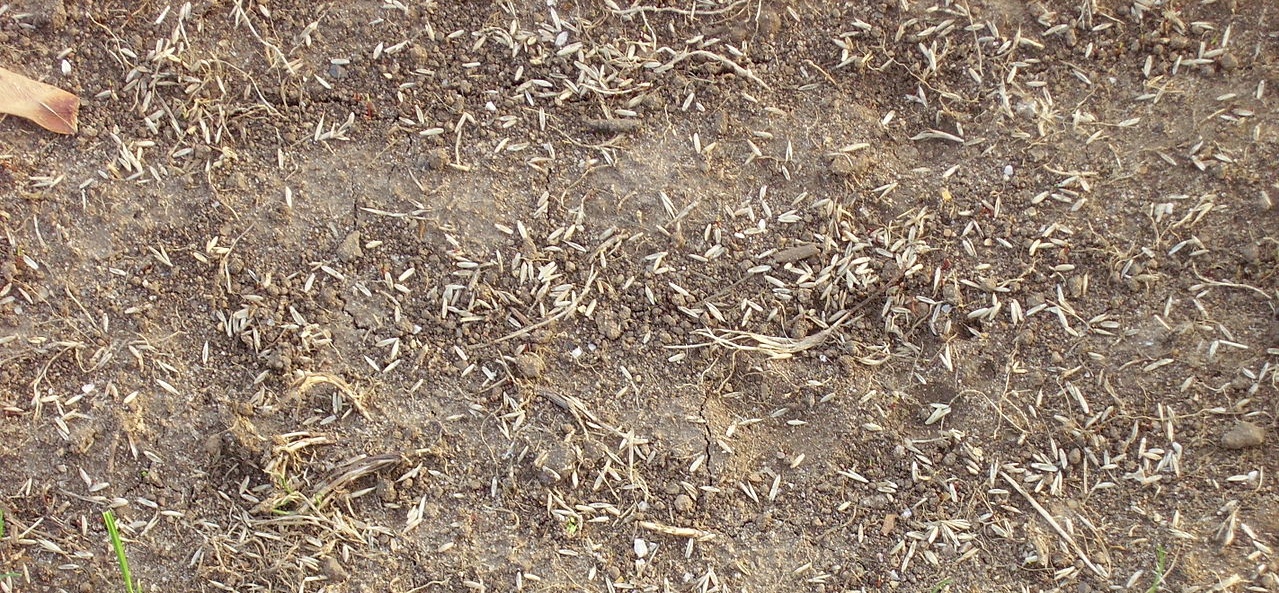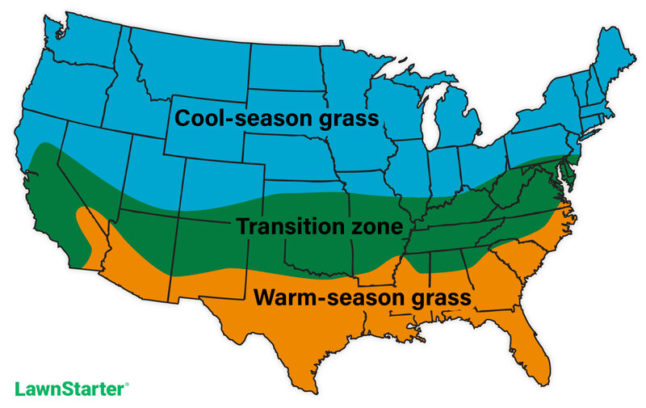What is a Grass Seed Thats Easy to Refill for Gardens

If your spouse keeps telling you the grass is greener on the other side of the fence, you might want to tackle the naked-earth lawn chore you've been dodging. We'll show you how to plant grass seed in six steps. You'll complete one of the most satisfying outdoor tasks a homeowner can accomplish (and maybe save your relationship).

Here's how to plant grass seed in six simple steps:
- Step 1: Remove the Existing Grass
- Step 2: Do a Soil Test, Then add Amendments
- Step 3: Choose the Best Seed for Your Region
- Step 4: Best Time to Plant Grass Seed
- Step 5: Aqua and Attention
- Step 6: When to Give Your New Lawn its First Mow
- FAQs
Step 1: Remove the Existing Grass
Is your lawn happily surviving? If your grass is good, but could be better, you could overseed to plump up the existing lawn. For bare spots, use garden tools to roughen up the soil first. Then spread the grass seed over to fill in the bare patches.
If your yard is where feisty weeds go to party and half of your lawn lies naked, you should plan to renovate — remove the old vegetation. New baby grass seedlings cannot compete with that mess. If you're starting from scratch with a new home build, and establishing a new lawn, you can skip to Step 2.
There are two ways to clean your lawn's slate:
- Use a nonselective broad-spectrum herbicide. Follow label instructions carefully and don't spray on a windy day.
OR
- Use a sod-cutter, available at most rental companies. Mark your sprinkler heads before operating the cutter to avoid accidents.
Once the weeds and old sod are removed, loosen the soil bed so the new grass seeds' roots can easily grow through. You can use hand tools (and your toughest friends), a tiller, or core aerator. You can find tillers and aerators at rental companies, as well.
Fill low spots in your yard using a half-and-half mixture of sand and topsoil. If necessary, grade your yard to keep rain or water flowing away from your home.
Step 2: Do a Soil Test, then Add Amendments
Once you have renovated your lawn – exposed and leveled the planting surface – you'll need to test your soil for the best grass germination and growth. Test the soil as soon as you can. There can be a wait of up to two weeks for results and you could miss your ideal planting window.
At a minimum, you should test for pH. This is a measurement of the acidity or alkalinity of your soil. Most grasses like slightly acidic soil, with a pH of 6.2 to 7.
A simple moisture and pH tester can be found for $10. For about $20, you could test for the major nutrients in your soil. Your results will show the N, P, and K: nitrogen, phosphorus, and potash.
The best soil tests include major and minor nutrients. Your state Extension service and private labs offer these services. Keep in mind your local Extension office can also provide great information and insight that private labs can't, and usually at a lower cost.
Here are four very good soil tests you can buy on Amazon.
The test results should give you a plan and shopping list for your local garden shop. Follow application instructions carefully and add soil amendments to restore what it lacks. Again, use a tiller or hand tools to work the amendments in to a depth of 1-4 inches.

Step 3: Choose the Best Seed for Your Region
Your local seed expert will always give you the best advice when choosing your seed. Local Extension offices, seed stores, and agricultural suppliers are experienced and understand the microclimates of your area.
In northern states, select cool-season grass, which grows best when temperatures are 60-75 degrees Fahrenheit. Cool-season grasses thrive in the late spring and early fall months in the northern two-thirds of the United States.
People living in Southern states should select a warm-season grass seed. Warm-season grasses thrive from late spring through summer.
Between the North and South is the transition zone where summers are hot and winters are cold. You'll either need to find the most cold-tolerant warm-season grass available, or the most heat-tolerant cool-season grass.
Best Cool-Season Grasses for Northern States
- Bentgrass is a standard grass for golf course putting greens. Colonial Bentgrass is for home lawns and likes a low mow.
- Kentucky bluegrass is a classic choice for Northern lawns. It likes full sun and isn't shade tolerant.
- Fine Fescue is a perennial bunchgrass and stands up in poorly drained areas.
- Tall fescue mix puts down deep roots and is drought tolerant.
- Creeping fescue is slow to germinate and spread, but tolerates shade, and is good for large lawns.
- Ryegrass (annual) can be used for a quick shot of green. The perennial ryegrass variety is best for high traffic and playgrounds.
Best Warm-Season Grasses for Southern States
- Bahiagrass has a coarse texture, is heat/drought tolerant, and is best for low traffic lawns.
- Bermudagrass is hardy and stands up to heavy traffic, but it's high maintenance.
- Buffalograss is the only variety native to North America, highly drought tolerant, and needs little care.
- Centipedegrass grows slowly but has very low maintenance once established. In warm climates, it's non-dormant, so it stays green year-round unless there's a cold snap.
- Zoysiagrass is a slow grower, but one of the most cold-tolerant varieties of warm-season grasses.
- St. Augustinegrass is sold as sod, as its seedheads are sterile.
Best Grasses for Transition Zone States
The transition zone is a blend of temperature highs and lows, humidity, summer deluges, and drought.
- Bermudagrass
- Kentucky bluegrass
- Perennial ryegrass
- Tall fescue
- Zoysiagrass
Single Variety, Blend, or Grass Seed Mix?
In addition to high-quality grass seed to match your climate, you also need to consider your lawn's unique properties.
- Is it in full sun, shade, or a mix? A shade mix is great for dense shade.
- How much moisture will it get?
- Is the area heavily trafficked?
- How much time and effort do you want to spend maintaining the lawn?
Knowing your terrain will help you home in on the formulation of seed you want. Seeds are sold as pure seeds of one variety, blends (multiple types of the same variety), and mixtures (seed blends of different varieties).
Pure seed will give you a unified look. Blends will be less uniform, but one variety may cover up for the weaknesses of another. Grass seed mixtures provide the most biologically diverse lawn: the grass plants won't look identical, but your lawn has a better chance of surviving diseases and droughts.
Step 4: Best Time to Plant Grass Seed
For cool season grass seeds, either spring or fall are the preferred times, since these northern varieties of grass prefer warm soil and cool air.
In the South, warm-season grasses can be planted from late spring to mid-summer. Wait until the last chance of a late frost has passed, and the daytime temperature is in the 80s.
One of the biggest keys to success is picking a high-quality seed that is right for your climate.
Federal Seed Act Ensures Proper Labeling
When it comes to selecting seeds, the Federal Seed Act requires seed sellers to provide consumers with valuable information on the seed's label.
Under the law, the label must tell you:
- The name of the grass variety (or varieties).
- Its purity, that is, the weight by percentage of each type of seed.
- Germination percentage. The percentage of the seeds that you can expect to germinate. This is not a number the seed companies can fudge. The federal government expects seed producers to run regular germination tests and keep careful records.
- Weed seed percentage. Look for a seed that has less than 0.5 percent weeds.
Pure Grass Seed or Fertilizer/Mulch Mix?
You have one final decision to make. Are you going to purchase a seed that incorporates fertilizer and mulch, or purchase fertilizer and mulch separately? The all-in-one products are more expensive but are convenient.
Measure your lawn area in square feet, and purchase enough seed to cover that area. Usually, seed bags are marked as the number of pounds needed per 1,000 square feet. If possible, buy a little more than needed in case you want to reseed some bare spots.
If you are fertilizing separately, broadcast the fertilizer according to the manufacturer's instructions.
Plant your Grass Seed and Fertilizer
To plant grass seed in small areas, hand-seeding is fine. For larger areas, seeders and spreaders provide more precise coverage. You can find hand-cranked spreaders, chest-mounted, or push-from-behind seeders. Drop seeders drop seeds directly below the unit. There are more expensive commercial seeding options as well.
Follow the instructions on the seed bag. If the seeder's lowest setting seems too generous with the seed, thin it out with sand or vermiculite.
- For large lawns, fill the push spreader with seed.
- Spread half of the recommended seed north to south.
- On the second pass, spread east and west for even coverage.
- Rake the top ⅛-inch of the seeded surface lightly. Using the back of a leaf rake side-to-side makes this an easy job.
- If you have access to one, roll an empty lawn roller to improve germination.
"We call it 'the seed-soil contact,'" said University of Illinois Extension office educator Richard Hentschel. "You want good seed-soil contact. If the seed and soil are not in intimate contact, the little root radicle may die out before it hits the soil." The radicle is the first root to emerge from a seed.
If you have hilly areas, seeds will tend to wash away to a low point. One potential solution is hydroseeding: broadcasting seeds that are suspended in a fertilizer-mulch slurry. Professional landscapers often offer hydroseeding services, and there are some hose-end sprayers for the do-it-yourselfers.
Lawn-Starting Fertilizer: Watch the Phosphorus
You need to find out if your state restricts using fertilizers containing phosphorus. Most laws carve out an exception and allow limited application of phosphorus on new lawns, but turf experts say to let your soil test be your guide. If it says that your soil lacks phosphorus, then it's acceptable.
Step 5: Aqua and Attention
Keep a careful eye on your new grass seeds. They only get one shot to germinate, so what you do now is critical. That means water. Keep in mind that different grass plants germinate at different times, so if you have a mixture of grass seeds, you'll need to keep watering them until the slowest-germinating species emerges.
- Keep the top layer of soil moist (but not soggy) down to 1/2 inch. (Too much water is as bad as too little, and overly vigorous watering could wash the seeds away.)
- Water at least once a day in the morning and perhaps again in the afternoon if the sun and wind have dried out the soil.
A misting attachment on your hose can cut down on the amount of force you use. Part of your lawn may be shadier, part may have more porous soil, or part may be sloped. Adjust your watering according to your lawn's needs.
Grass Seed Germination Rates, by Grass Type
- Bahiagrass seed: 10-28 days
- Bermudagrass seed: 7-28 days
- Kentucky Bluegrass seed: 14-21 days.
- Buffalograss seed: 7-10 days.
- Centipede grass seed: 14-28 weeks.
- Fescue grass seed: 10-14 days.
- Annual ryegrass seed, perennial ryegrass seed: 5-10 days.
- St. Augustinegrass: Rarely grown from seed, propagated by plugs and sod.
- Zoysia grass seed: 14-21 days.
Even if you planted just one turfgrass variety, the grass seeds won't all pop up at once. Some will be buried a bit deeper or have a different rate of water absorption. Stay with your watering regimen until you're sure the seeds have germinated.
Keep foot traffic to a minimum. You could consider putting up "Please keep off the new grass" signs to discourage accidental trampling by your kids and neighbors (and their dogs).
Step 6: When to Give your New Lawn its First Mow
Hooray! Your new lawn is green and it's growing well.
Here's how tall your grass should be before you mow for the first time:
- Bahiagrass: 2-2 ½ inches
- Bentgrass: 1 inch
- Bermuda: 1½-2 inches
- Bluegrass: 2-2½ inches
- Buffalograss: 2-3 inche
- Centipede: 1½-2 inches
- Fescue: 2-3 inches
- Perennial Ryegrass: 2-3 inches.
- Zoysia: 1-2 inches
Treat your New Grass like a Baby
Take advice from the '70s band, The Eagles. Slow down and take it easy the first few times you mow your new turfgrass. The roots won't be long or well-established, so it will be easy to accidentally rip up the young plants.
Here are a few tips to ensure a successful first mow:
- Sharpen the mower's blade so you cut, not tear, the tender plants.
- Start the mower off the lawn and minimize the number of turns you make with the mower.
- Don't remove more than a third of the grass blade in one mow.
After the first mow, cut back on frequent shallow watering, and switch to watering a couple of times a week, deeply. Water six or eight inches deep to encourage your new lawn to root deeply. Once established the lawn will start spreading to cover any gaps.
After eight weeks, your lawn should be well-established. Hit it with a little more fertilizer to encourage deep roots, and take down your "Please keep off the new grass" signs; your new lawn is ready for fun.
FAQ
Does Grass Seed Grow if I Throw It on the Ground?
It's unlikely that grass seeds will grow on top of flat, bare soil. The seeds may germinate but the roots won't be strong enough to penetrate the soil. It's best to rough up the soil before sowing for the best seed-to-soil contact.
Does Grass Seed Need to be Covered?
Don't cover grass seed with topsoil. The seed needs light to germinate. To protect the seed from birds and washing away, use straw (weed-free) or an erosion-control blanket.
How Long Until My Grass Pops Up?
Expect to see tiny grass blades in 10-14 days. Other varieties of seed may take up to 30 days.
DIY or LSE (Let Someone Else)?
Some homeowners and renters love being weekend warriors, but some of the rest of us prefer anything else.
If you're like me, and you would rather reap the rewards of great grass someone else sowed and mowed, consider hiring a lawn care pro. Give them a call early so they can begin testing and sowing seeds at the proper planting time for your area.
* Editorial Note: LawnStarter participates in the Amazon Services LLC Associates Program, an affiliate advertising program. LawnStarter may earn revenue from products promoted in this article.
LawnStarter writer Penny Warner updated this article.
![]()
Daniel Ray
Daniel Ray is LawnStarter.com's former editor in chief. He is an award-winning writer and editor who previously was editor in chief of the personal finance websites Bankrate.com and CreditCards.com, but with 30 years of gardening experience, he's well qualified to help consumers grow a different kind of green.
Source: https://www.lawnstarter.com/blog/grass-seed/grow-grass-from-seed/
0 Response to "What is a Grass Seed Thats Easy to Refill for Gardens"
Post a Comment